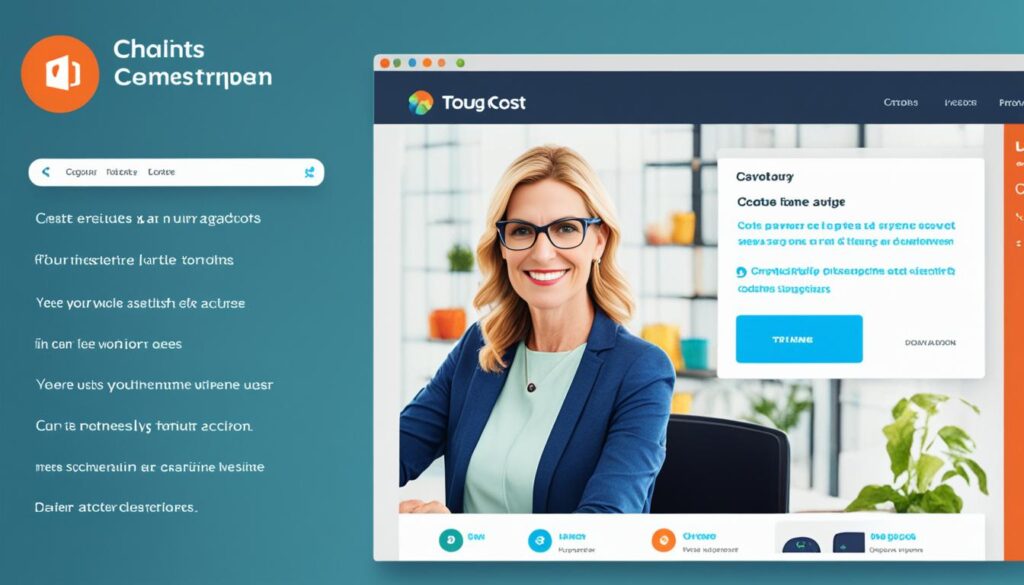
Search engine optimization (SEO) is key for digital marketing achievement, especially in competitive fields. These include legal services, health, finance, real estate, education, travel, and e-commerce. Advanced SEO strategies are vital if you want to shine in these areas.
Enhancing user experience (UX) is a major part of advanced SEO. It means making your site faster, mobile-friendly, and secure. A website that works well and is safe makes visitors happy. This boosts how much they interact with your site and helps you rank higher in searches.
It's also crucial to match your content with what users are looking for. This is known as user search intent. Find out why someone’s searching and then create content that meets those needs. By providing relevant and valuable info, your site will show up more often in search results.
Key Takeaways:
- Optimizing user experience (UX) is crucial for SEO success.
- Aligning content with user search intent improves visibility in search results.
- Competitive industries require advanced SEO strategies for standing out.
- Consider implementing topic clusters to improve site structure and navigation.
- Thorough keyword research and building high-quality backlinks are essential for better rankings.
Optimizing User Experience
To boost your website's SEO, focus on user experience (UX). Google looks at UX signals that affect rankings and user actions. Things like how fast pages load, if they're easy to use on mobile, how safe they are, and their core web vitals matter a lot. Make these better, and you'll improve how long users stay on your site and how many stick around.
Improving page speed is crucial. When a site takes too long to load, it turns users off and can hurt your SEO. Both people and search engines like sites that load quickly. Use tools like PageSpeed Insights to find and fix slow spots on your site. This way, visitors will enjoy their time there more.
Being mobile-friendly is also key to a good user experience. Since lots of people use phones and tablets to browse, Google loves sites that welcome mobile users. Make your site fit different screens well, and you'll make both users and search engines happier.
Site security is a big deal for users too. They want to know their info is safe online. An SSL certificate and HTTPS make your site more secure and give a thumbs-up to search engines. Sites that protect their visitors often get better rankings and more visitors.
Don't forget about core web vitals. Metrics like how fast pages load, how soon users can interact with them, and if they move around too much when you first see them matter a lot. Working on these core vitals improves user engagement and makes browsing your site smoother.

Better user experience helps your site's SEO and makes visitors like your site more. Focus on page speed, mobile-friendliness, security, and core web vitals. This will create an experience people enjoy so much, they'll want to stay, look around, and maybe even buy something.
| User Experience Factors | Impact |
|---|---|
| Page Speed | Affects bounce rate and session duration |
| Mobile-Friendliness | Influences rankings and user engagement |
| Site Security | Boosts user trust and SEO rankings |
| Core Web Vitals | Enhances overall browsing experience |
Aligning Content With Search Intent
One big aspect of SEO work is matching your content with what users are searching for. Search intent is the goal behind a user's search. Understanding what users want helps us provide the information they need.
To match our content with search intent, we look at the words users would use. Using these keywords naturally helps our content show up in their searches.
It's key our content meets what users expect. This includes living up to what the title and description promise. Skip the click-bait and aim for titles that are honest and draw the user in.
Content creation should offer answers to what users are looking for. By meeting their search intent, we up the chance that users will find and like our content. This strategy betters our search rankings and builds trust with our audience.
Users search for all kinds of things. Some want direct answers or fixes, while others seek out more general info or research. Knowing these differences helps tailor our content for everyone.
"By aligning our content with search intent, we demonstrate to search engines that we understand the needs of our audience and are providing valuable information."
Implementing Topic Clusters for Cohesive Content Strategy
Want to boost your website's search ranking? Use topic clusters. This method groups your site's content into a main "pillar page" and smaller subtopic pages. It makes navigating your site easier for both people and search engines.
Topic clusters help organize your website clearly. Linking your main pillar page to its subtopics aids search engines in understanding your content. It also makes your visitors' experience smoother, leading them to what they're looking for.
Internal links are vital in topic clusters. They tie the pillar page and subtopics together. This process shows search engines that your pages relate to each other. As a result, your site is easier to explore and ranks better in search results.
Using topic clusters can also make people stay on your site longer. When you cover a topic and its subtopics fully, readers are more likely to continue reading and browsing. This helps your site's standing with search engines, too, pushing you up in the search results.
FAQ
What are advanced SEO strategies?
Advanced SEO strategies aim to boost a site's ranking in busy industries. They help sites stand out. These include making the user's experience better, matching content with what people search for, and other techniques.
You also work on making topics easy to browse. It involves picking the topics that your site will be known for. This makes your site easier to find and use. These strategies help your site get noticed by more people.
Why is user experience important for SEO?
User experience greatly impacts how well your site does in searches. Google looks at how visitors experience your site. Fast loading, being phone-friendly, and safe to use are big pluses.
These things can raise or lower how many people stay on your site or buy things. Better experiences keep people on your site longer. This is a big deal for SEO.
How can I align my content with search intent?
Create content that meets what users are looking for to match search intents. This means using phrases that answer what someone might be searching for. It's also about being clear and honest in your titles.
Focus on what people hope to find when they search. Make sure your content delivers on that promise.
What are topic clusters and how do they improve SEO?
Topic clusters center on a main topic and its subtopics. The key is a strong pillar page and links to related ones. This makes your site more organized and helpful to visitors.
Visitors find the information they want more easily. This can increase how long they stay on your site. Google sees this as a good thing, which boosts your site's search ranking.











